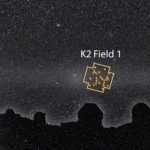W. M. Keck Observatory press release…
An international team of astronomers have discovered and confirmed a treasure trove of new worlds. The researchers achieved this extraordinary discovery of exoplanets by combining NASA’s K2 mission data with follow-up observations by Earth-based telescopes including the W. M. Keck Observatory on Maunakea, the twin Gemini telescopes on Maunakea and in Chile, the Automated Planet Finder of the University of California Observatories and the Large Binocular Telescope operated by the University of Arizona. The team confirmed more than 100 planets, including the first planetary system comprising four planets potentially similar to Earth. The discoveries are published online in The Astrophysical Journal Supplement Series.

In its initial mission, Kepler surveyed a specific patch of sky in the northern hemisphere, measuring the frequency with which planets whose sizes and temperatures are similar to Earth occur around stars like our sun. But when it lost its ability to precisely stare at its original target area in 2013, engineers created a second life for the telescope that is proving remarkably fruitful.
The new mission, dubbed K2, has provided the capability of observing a series of independent target fields in the ecliptic plane with greater opportunities for Earth-based observatories in both the northern and southern hemispheres. Additionally, in contrast to the Kepler mission, K2 is an entirely community-driven mission with all targets proposed for by the scientific community. K2 now looks at a larger fraction of cooler, smaller, red dwarf-type stars, which are much more common in our Milky Way than sun-like stars.
“Kepler’s original mission observed a small patch of sky as it was designed to conduct a demographic survey of the different types of planets,” said Ian Crossfield, a Sagan Fellow at the University of Arizona’s Lunar and Planetary Laboratory, who led the research effort. “This approach effectively meant that relatively few of the brightest, closest red dwarfs were included in Kepler’s survey. The K2 mission allows us to increase the number of small, red stars by a factor of 20 for further study.”
One of the most interesting set of planets discovered in this study is a system of four potentially rocky planets, between 20 and 50 percent larger than Earth, orbiting a star less than half the size and with less light output than the Sun. Their orbital periods range from five-and-a-half to 24 days, and two of them may experience radiation levels from their star comparable to those on Earth.
Despite their tight orbits — closer than Mercury’s orbit around the sun — the possibility that life could arise on a planet around such a star cannot be ruled out, according to Crossfield.
“Because these smaller stars are so common in the Milky Way, it could be that life occurs much more frequently on planets orbiting cool, red stars rather than planets around stars like our sun,” Crossfield said.
To validate candidate planets identified by K2, the researchers obtained high-resolution images of the planet-hosting stars from Keck Observatory’s near infrared camera (NIRC2), the Gemini and Large Binocular Telescope (among others) as well as high-resolution optical spectroscopy using Keck Observatory’s high resolution spectrograph (HIRES) instrument and the AUtomated Planet Finder. By dispersing the starlight, the spectrographs allowed the researchers to measure the physical properties of a star — such as mass, radius and temperature — and infer the properties of any planets orbiting it.
“Our analysis shows that by the end of the K2 mission, we expect to double or triple the number of relatively small planets orbiting nearby, bright stars,” Crossfield said. “And because these planets orbit brighter stars, we’ll be able to more easily study everything possible about them, whether it’s measuring their masses with Doppler spectroscopy — already underway at Keck Observatory and APF — or measuring their atmospheric makeup with the James Webb Space Telescope in just a few years.”
For a full list of authors and funding information, please see the research paper, “197 Candidates and 104 Validated Planets in K2’s First Five Fields,” available for download at https://www.lpl.arizona.edu/~ianc/docs/crossfield…

